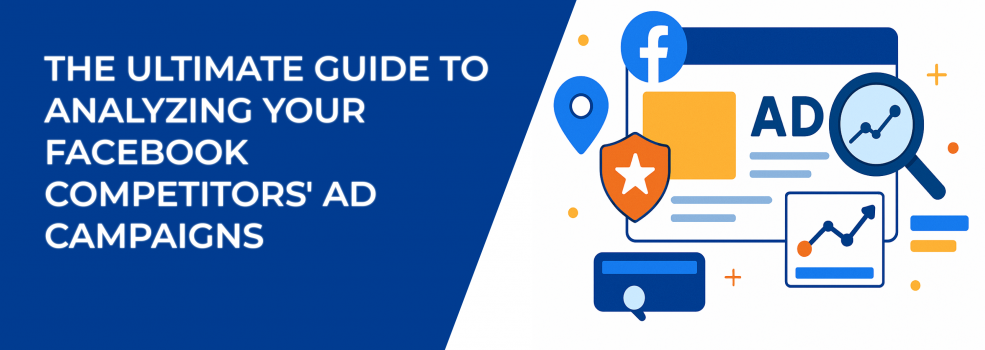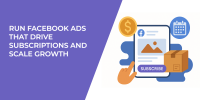You’re putting time and money into your Facebook ads. You’re testing headlines, adjusting creatives, trying new audiences. But how do you know where you stand? How do you figure out what’s working for others in your space and how you can use that to improve your own performance?
Analyzing your competitors’ ad strategies is a powerful way to gain perspective. It’s not about copying their work. It’s about understanding the direction your market is moving, identifying what messages get traction, and seeing where you might improve your positioning.
Here’s how to study your competitors’ Facebook ad campaigns in a way that brings real value to your business — and gives you clear next steps.
Why it’s worth paying attention to competitors' Facebook ads
Facebook and Instagram ads aren’t set-and-forget. You’re working within a dynamic system driven by relevance, engagement, and cost-efficiency. The ads that perform best are usually the ones built on informed decisions.
When you take the time to analyze what others in your market are doing, you can:
-
Identify proven creative formats and messaging styles,
-
Spot trends in offers, targeting, and timing,
-
Reduce wasted spend by learning from others’ tests,
-
Find overlooked angles or messaging gaps.
Let’s say you notice that five direct competitors are all running ads with video testimonials. That tells you something. Not just about what’s trending but about what’s likely converting right now in your category.
By tracking this type of detail regularly, you can make faster decisions and run smarter campaigns.
Using the Meta Ads Library to decode what your competitors are doing
Most advertisers know the Meta Ads Library exists. Few use it to its full potential. It’s not just a catalog of running ads — it’s a live data resource showing how your competitors think about creative, platforms, timing, and targeting strategy.
If you haven’t been using it actively, here’s why that needs to change.
The Meta Ads Library allows you to:
-
Browse all currently active ads across Facebook, Instagram, Messenger, and Audience Network.
-
Search by keyword, advertiser, topic, or Page name to narrow in on specific campaigns or competitors.
-
See exactly when ads started running, which gives you a sense of campaign duration and consistency.
-
Compare versions of dynamic ads to study how creative variations are tested.
-
View platform placements (e.g., are they focusing on Instagram Stories or Facebook Feed?).
-
Use filters to sort by region, media type (image, video, etc.), language, and activity status.
This makes the Ads Library one of the most accessible tools for competitive analysis on the Meta platform.
How to use it effectively:
1. Study creative in context.
-
Look at not just what’s being advertised, but how.
-
Are competitors using direct-response language or storytelling?
-
Are creatives built around UGC, professional photography, or animation?
-
Do ads differ by placement (e.g., vertical video for Reels vs. square images for Feed)?
Try comparing how one brand adjusts its messaging across Instagram vs. Facebook. You'll start to understand how they optimize for different audience behaviors.
You can look up Facebook ads of both big brands and small businesses depending on who you're competing against.
2. Track longevity.
A long-running ad often points to stable performance — especially if it's running across multiple placements. If a brand keeps the same creative live for several months, it likely indicates some level of ROI.
-
Flag these for your inspiration board.
-
Ask: What’s making this ad sustainable? Offer clarity? Simple visual cues? Targeting?
By contrast, ads that disappear quickly might suggest experimentation — or underperformance.
3. Review Advertiser Transparency Details.
When you search for a brand or Page, Meta will show:
-
All Pages owned or managed by the business,
-
Changes to Page ownership or name,
-
Geographic distribution of Page managers.
While this doesn’t tell you everything, it gives context: is this a local brand scaling fast? Are they managing ads across multiple fronts?
4. Explore audience focus with location filters.
The location filter is useful for more than just browsing. It gives you insight into how brands localize their creative.
For instance, if you’re selling products in both the U.S. and Germany, you can filter ads shown in each region — and compare messaging, visuals, even tone.
This is a smart way to fine-tune localized campaigns. What works in one market might underperform in another — and the Ads Library lets you explore that without running expensive tests yourself.
5. Examine ad versions and iteration styles.
When you spot a brand running multiple versions of the same ad (with slight changes in visuals or copy), you’re looking at real-time A/B testing.
-
Are the variants testing headlines, colors, or layouts?
-
Is one CTA "Shop Now" while another says "Learn More"?
-
Are product-focused ads paired with story-based ones?
This helps you understand how brands refine their performance — and what your own creative roadmap could look like over time.
6. For political or issue-based ads, get deeper data.
If you're browsing ads related to social issues, elections, or politics, Meta will show:
-
Impressions, spend range, and audience geography,
-
Advertiser contact information,
-
Demographic targeting details (for EU-based ads).
While this might not apply to your day-to-day campaigns, it demonstrates how much granular data Meta can expose when legally required. It’s worth noting how these campaigns are built — especially if you work in advocacy, nonprofits, or regulated verticals.
7. Use the Meta Ad Library API (for advanced users).
If you're managing a high number of campaigns or need programmatic access to competitor data, the Meta Ad Library API can automate this.
With it, you can:
-
Track ad trends across multiple Pages at scale,
-
Integrate ad data into internal dashboards or reports,
-
Query historical ad performance in specific regions or formats.
To use the API, you'll need a Meta for Developers account and an access token. It’s best suited for agencies, analysts, or brands with significant data infrastructure.
What you can’t see in the Ads Library
The Ads Library shows you the creative and message. But what about targeting?
This is where most advertisers hit a wall. You can see what your competitors are saying — but not who they’re saying it to.
And that gap matters. Because even the best ad won’t perform well if it’s delivered to the wrong audience.
So how do you find out who they’re actually reaching?
Using LeadEnforce to target competitor audiences
LeadEnforce makes it possible to build Facebook custom audiences based on users who follow Facebook groups and Instagram pages that your competitors own. This means you can reach the same audiences your competitors are already connected with.
Let’s take an example: imagine you run an online course for beginner photographers. One of your competitors is a popular YouTube creator with a Facebook group that has 50,000 members. That group's audience is exactly the group you want to reach — people who are already interested in learning photography.
With LeadEnforce, you can:
-
Build a custom audience from that creator’s Facebook group or Instagram page,
-
Use that audience in your Meta Ads Manager,
-
Run your own campaigns targeting those users — with your own offer and creative.
It’s a practical way to shift from guessing to targeting people with proven interest in your niche.
Here are some tips for using LeadEnforce effectively:
-
Target multiple sources — combine the audiences of several relevant Facebook groups to reach a broader but still relevant group of users.
-
Segment smartly — test audiences built from Instagram pages separately from those built from Facebook groups. Engagement behaviors may differ.
-
Combine with lookalikes — once your LeadEnforce audience delivers strong results, build a Lookalike to expand reach while maintaining relevance.
-
Use for retargeting — these users are already warm. Follow up with testimonials, product demos, or behind-the-scenes content to build trust.
This type of audience targeting helps you move past broad interests like “fitness” or “travel” and connect with real users who are already engaging with competitors or communities in your space.
Going for a deeper competitive analysis
Once you’ve gathered creative examples and built competitive audiences, the next step is interpretation. Ask yourself: what can I learn from the choices they’re making?
Here are some areas worth analyzing:
- Frequency and volume: are your competitors running five versions of one concept — or just one or two high-performing ads? Volume can indicate budget, testing strategy, or even campaign objectives.
- Message shifts: look for subtle changes. If a brand switches from focusing on product features to emphasizing lifestyle benefits, they’re likely responding to performance data.
- Landing pages: click through their ads. Where do they send traffic — straight to checkout or to a quiz, lead form, or article? Your competitors’ funnels reveal how they convert interest into action.
- Seasonal behavior: are they running aggressive promotions during specific periods? You don’t need to copy their calendar, but it can help you plan your own.
Keep a log of these insights. Over time, you’ll build a sharper sense of what’s typical in your niche — and where there’s room to test a different approach.
Even with great research, there’s a risk: following others too closely.
If you mirror your competitors too literally — same tone, same design, same offer structure — you disappear into the noise. Their playbook might work for them, but your edge comes from offering something distinct.
Use your findings to:
-
Spot creative gaps others aren’t filling,
-
Build messaging that addresses missed pain points,
-
Present a unique value proposition that’s clear and specific.
Competitive research should guide your decisions, not replace them. The goal is differentiation with context — not imitation.
Final thoughts
When you take a focused, structured approach to analyzing your competitors’ Facebook ads, you give yourself an informed foundation to build on.
Use Meta Ads Library to track their creative direction and messaging patterns. Use LeadEnforce to target the same audiences they’re reaching, but on your terms. Pay attention to the details: what’s changing, what’s consistent, what’s being tested.
From there, test deliberately. Launch campaigns that reflect what you’ve learned — not just from your own data, but from what’s already happening across your industry.
You're not following: you're adjusting based on evidence. If you're ready to take your Facebook advertising to the next level, sign up for a LeadEnforce free trial and start targeting your competitors' audiences.

